
What Indian Parents Really Think About Online Learning?
I The pandemic backdrop!
It’s a foregone conclusion that the pandemic has forced online learning down the throats of most parents & students across the world. But while it was a shock for the students, it must be mentioned that it actually came as no less of a shock for the education fraternity. The teaching fraternity, in fact, is still reeling and need more than just time to adjust to this new learning paradigm that they have been presented with. They – most importantly – need the right tools to deliver education online, because while the online learning model is not new, it’s adoption was hitherto a choice. Now it is not.
Almost a year & a half into the pandemic, most offline learning models have had no choice but to transition to online modes. And whether we like it or not, the prevalence of the online learning model will last comprehensively for at least a year more.
In this period, it is expected that a lot of educators and students will find their feet and build a certain degree of comfort with the online learning platforms and methods. And come to deeply appreciate its ability to deliver at scale and its promise of flexibility that brings so many marginalised communities and factions into the online learning fold. If & when we transition back to the offline mode, it is a given that learning and education would henceforth be mostly hybrid – offline and online!
I The objective of this survey-series
It is against this context that we at ‘lightbulb’ wanted to understand the ‘Indian Parent’.
From being a provider of funds and direction to being an active collaborator for the educator, the Indian Parent has come a long way. It is critical at this juncture to examine from their perspective – what they feel about online learning, it’s benefits, it’s gaps, it’s results and most importantly it’s potential.
As the purchase decision makers for online learning businesses, the Indian Parent is the single most misunderstood party and this series of surveys are an attempt to hear from them about the single most powerful force for good that the world has seen in recent times – online learning.
I Let’s establish the basics…
For the 1st article in this series, we surveyed 108 Indian parents – all from the affluent SEC A category resident in metro cities in India and between the ages of 32-45 years, primarily female. Please read ahead for unadulterated results.
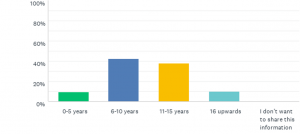

From the 108 parents surveyed, the overwhelming majority had children between the ages of 6-15 years, for whom the shift from a regular day-school to online schooling from home, has struck them all with the impact of a tsunami.
Especially for younger age groups from 6-10 years, this has been a particularly challenging time, as they require much closer supervision from parents on a daily basis – supervision that parents find it difficult to give with no help at home & a work-from-home reality for most parents.


From a scenario where children were out of home from anywhere between 4-8 hours, giving working and non-working parents time to attend to their work, the significant majority – over 96% – is now learning from home for anywhere between 3-6 hours daily.
This is now starting to place significant stress on shared resources like study space at home, WiFi bandwidth and electronic devices available at home.
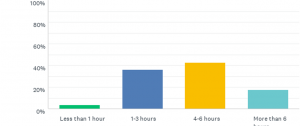

In a lot of cases, parents are having to make significant additional expenditure to make additional electronic devices available for the exclusive use of their children, on a daily basis, as children spend anywhere from 1-3 hours in primary school and from between 4-6 hours daily in secondary school on their devices.
This time, of course, does not take into consideration, the amount of time spent by students on completing their homework and assignments as well as on research projects and additional learning or classes that they have in addition to their school curriculum. The actual hours spent online for most older children would therefore range between 8-10 hours daily.
I Have preferences changed?
In the past one and half years, most parents observed with resignation & then amusement that while their children were initially delighted to not have to wake up early, go to school and submit assignments or do homework, the tide changed halfway.
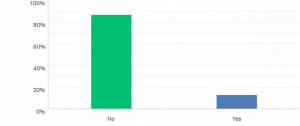

As social isolation crept in and the lack of access to their friends and school activities set in, children too started getting disillusioned with the strictly online learning model that the pandemic has enforced.
Most parents today report that the children are longing to get back to their real school lives!
In the meanwhile, all of us as parents have also definitely realised that current quality of online learning is not at par with in-class experience where teachers are present, engaged and more attuned to the attention & engagement level of their students.
An additional grouse that parents have is that, given the home learning model, a lot of onus has been shifted onto the hapless and busy parents by the teachers & schools.


From ensuring compliance with the standards demanded, to engaging more with children after school to clear doubts etc, parents are having to get more and more involved with their children’s daily learning and progress.
Against this backdrop, it is no surprise that over 87% of the parents surveyed, preferred the older offline learning model to that of today’s online learning practices.
I Emerging areas of concern
Overall, as the online teaching experience extends its tentacles to engulf the parents and demands a collaborative effort between teachers, students and parents, the outcomes unfortunately don’t reflect the efforts made.
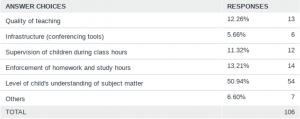

Despite best efforts, most parents surveyed weren’t happy with the overall learning outcomes with ~54% parents reserving judgement and unable to make up their minds while ~31% were clearly dissatisfied with the learning outcomes from the online learning experience.
In fact, to bring the quality of the online learning experience up to par with the physical in-class experience, a lot of parents felt that the input parameters themselves needed drastic improvement – from the quality of teaching, to the infrastructure, to the supervision of children during class hours to the enforcement of homework and study hours.
However it is interesting to note that the point of greatest concern was whether students were actually understanding the subject matter that was being taught in classes.
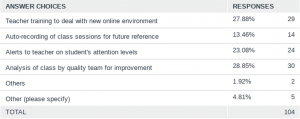

And to most parents, the onus lay on the schools, teachers and online learning businesses with a clear ask for them to improve the learning outcomes from online learning. From the options that parents advocated, the top-preferred were increased amounts of teacher-training to handle online tools, as well as the analysis of the quality of live classes on a periodic basis via monitoring by teacher-training teams and of course, the delivery of notifications & alerts to teachers on the attention levels of students, to enable them to handle a large number of students.
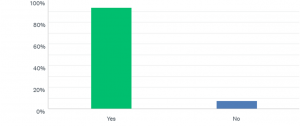

In fact, the key ask from parents was clear – that they strongly felt that the teachers should ensure that their students are paying attention in class.
And while this was hard enough to ensure in the real-world when the students were literally in front of the teachers all day, it is practically an unsurmountable problem for teachers online as they handle large classes of students from their homes, unaided and without the right tools and technology to help duplicate the teacher-to-student in-class experience.
I In conclusion…
As online learning moves from an exception to a norm, these and more challenges will crop up for parents, student and the online learning businesses who choose to venture into this space.
We will continue to interact with these groups and channel feedback and insights your way. Keep an eye on this space for more such articles & follow us on Linkedin for periodic insights and news!
About Lightbulb…
The founders of Lightbulb.ai are all parents themselves and these concerns & thoughts resonate with us, as this is the reality that we live with in our homes everyday, like you, dear reader! These concerns were the vision behind Lightbulb, our emotion & engagement analytics platform that helps online learning businesses complete the loop of human-to-human communication that is currently disrupted by the digital medium.
Our vision is to improve learning outcomes for students, by human-izing the process of online learning. And we do this via our ‘Live Class Monitoring’ solution that not only provides alerts to teachers on student attention levels, for them to provide the requisite timely support needed but also provides insights to the teacher-training teams on the quality of teaching for them to complete the feedback loop to their teachers.












